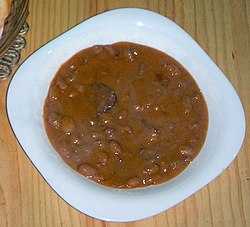 A plate of caparrones stewed with chorizo | |
| Type | Stew |
|---|---|
| Place of origin | Spain |
| Region or state | La Rioja |
| Main ingredients | Caparrón (red kidney beans), chorizo |
Caparrones is a Spanish stew made of caparrón, a variety of red kidney bean, and a spicy sausage chorizo, both of which are local specialties of the Spanish La Rioja region. The shape of caparrón bean is shorter and rounder than common red kidney beans. The stew is regarded as one of the most important dishes in Riojan cooking.[1]
Its cultural importance in the region can be compared to Asturian fabada. Caparrones are associated with strength, as well as with flatulence. There are some restaurants and inns in La Rioja that take this name (Mesón los Caparrones, etc.).
This plant is widely cultivated in groves around La Rioja, and the most famous are from Anguiano where a yearly festival is held honoring these beans.[2]
Rods obtained from branches of trees like poplar or bushes like elder and used for guiding the plant's growth are called palos de caparrón (caparrón staves). These staves are saved from one year to another tied in bunches called gavillas. There are also some varieties of caparrones called sin palo (without a stave) because they do not grow very tall and so do not require artificial support.

See also[edit]
References[edit]
- ^ "Castañares: Los Caparrones de Castañares". www.castanaresderioja.org. Retrieved 2019-05-19.
- ^ "Festival de la alubia de Anguiano - Cocina Tradicional Riojana". Archived from the original on 2012-03-28. Retrieved 2011-03-02.
External links[edit]
Well, that’s interesting to know that Psilotum nudum are known as whisk ferns. Psilotum nudum is the commoner species of the two. While the P. flaccidum is a rare species and is found in the tropical islands. Both the species are usually epiphytic in habit and grow upon tree ferns. These species may also be terrestrial and grow in humus or in the crevices of the rocks.
View the detailed Guide of Psilotum nudum: Detailed Study Of Psilotum Nudum (Whisk Fern), Classification, Anatomy, Reproduction